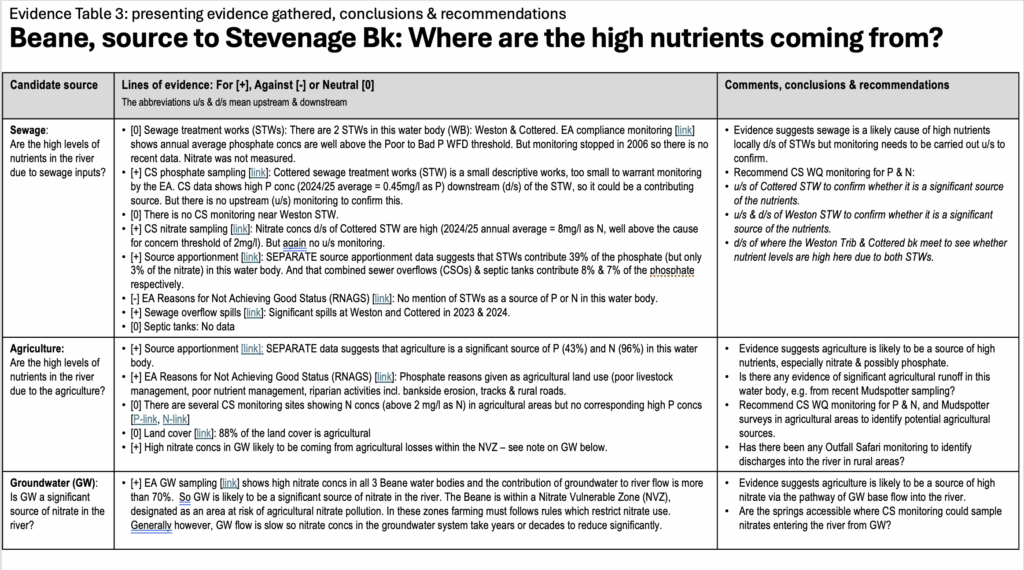What do we mean by Weight of Evidence?
When we talk about evidence*, we don’t just mean raw data. Valuable information can come in many forms: water quality samples, survey results, local observations, photographs or official records. Each source has its own strengths and limitations, but when you bring them together, they create a more complete picture of issues with river health and catchments.
This is what we call the Weight of Evidence (or WoE). Here, “weight” means the ability to balance different types of information to build a picture that can guide decisions.The picture is never perfect or complete. This approach can help groups develop a shared understanding of the issues, build trust, reach consensus, and decide what action to take. Different pieces of evidence can either refute or support an assumption.

Why use a ‘Weight of Evidence’ approach?
Environmental decisions, whether about restoration, regulation, or risk, are never black and white. They require us to interpret information in context, especially when different sectors, disciplines, and monitoring methods are involved.
The Weight of Evidence approach helps by:
- Bridging data gaps by combining quantitative and qualitative information.
- Building a shared picture that groups can use to agree on issues and priorities.
- Improving transparency by showing how information from different origins is considered.
- Making space for local knowledge, including citizen science contributions alongside professional monitoring.
- Supporting proportionate decisions, especially when action is needed despite uncertainty.
- Identifying where more information is required to help confirm an assumption – this may, for example, include taking mroe samples or collecting from different locations or parameters or making more frequent observations.
Even if the picture isn’t perfect, it can still be enough to move forward together.
What types of data can be included?
- Regulatory and compliance monitoring data
- Academic and research datasets
- Citizen and community science data and observations
- Modelling outputs and remote sensing
- Historical or legacy data
- Photographic evidence or field notes
Each of these types has strengths and limitations. A Weight of Evidence (WoE) approach acknowledges this by using structured methods to evaluate their relevance, reliability, and contribution to the overall question or assumption.
How to apply it in practice
There is no single recipe for applying a Weight of Evidence approach. The key is to use the information available in a structured way that supports collective decision-making. Most approaches involve:
- Defining the decision context: What question are you trying to answer, and what decision needs to be supported?
- Identifying all relevant sources of information: From regulatory data to citizen observations, photos, models, and historical records.
- Assessing data quality and uncertainty: Recognise strengths, gaps, and limitations in each source.
- Weighing the information: Compare and balance findings across sources to see where they align or diverge.
- Developing a shared understanding: Use the combined picture to agree on issues and priorities.
- Drawing conclusions with justification: Document how you reached your decision so it is transparent and repeatable.
Example: Beane Demo Catchment
Below is an extract from the Beane Demo Weight of Evidence analysis. You can view the full analysis pdf here and read more in their case study.


Inspiration: Foundations of Weight of Evidence
These examples from “Evidence & Measures” programme (created for Defra and the Environment Agency) are 2-page foundational case studies that informed the Weight of Evidence approach in CaSTCo.
- The Value of a Longer-Term View: Using Variations over Time to Understand Catchments (pdf)
- Consented Discharges: Processing and Making More of Available Data (pdf)
- Downstream Changes in Water Quality and Biology: Generating Evidence For or Against Suspected Causes (pdf)
- Strength of Evidence Tables: Helping to Make Decisions on Causes of Poor Status (pdf)
- Using Pollution Incident Data: Databases and Making More of NIRS (pdf)
- Urban Pressures: Storm Overflows, Wrong Connections and Landfill (pdf)
- The Value of the Past: Use of Old Reports, Data and Opinions (pdf)
Weight of Evidence in CaSTCo
The CaSTCo project embraces Weight of Evidence as a key principle. Our catchment-based approach brings together statutory agencies, local experts, researchers, and citizen scientists to co-design monitoring plans that reflect shared priorities.
We’re developing tools and case studies that demonstrate how data from different sources can be meaningfully combined, even when methodologies differ. This helps move us from data collection to decision-making faster without compromising on rigour.

Weight of Evidence applied in CaSTCo demontrator catchments
Many of the demonstrators combined data sources to help them make evidence-informed decisions, including the Teme exploring bacteria monitoring, the Ribble’s blitz events identifying issues and solutions, and Thames 21 using Outfall Safari and other data to identify missed connections.
* Evidence is ‘relevant information used to assess one or more assumptions related to a question of interest’ (modified from Salafsky et al., 2019)
